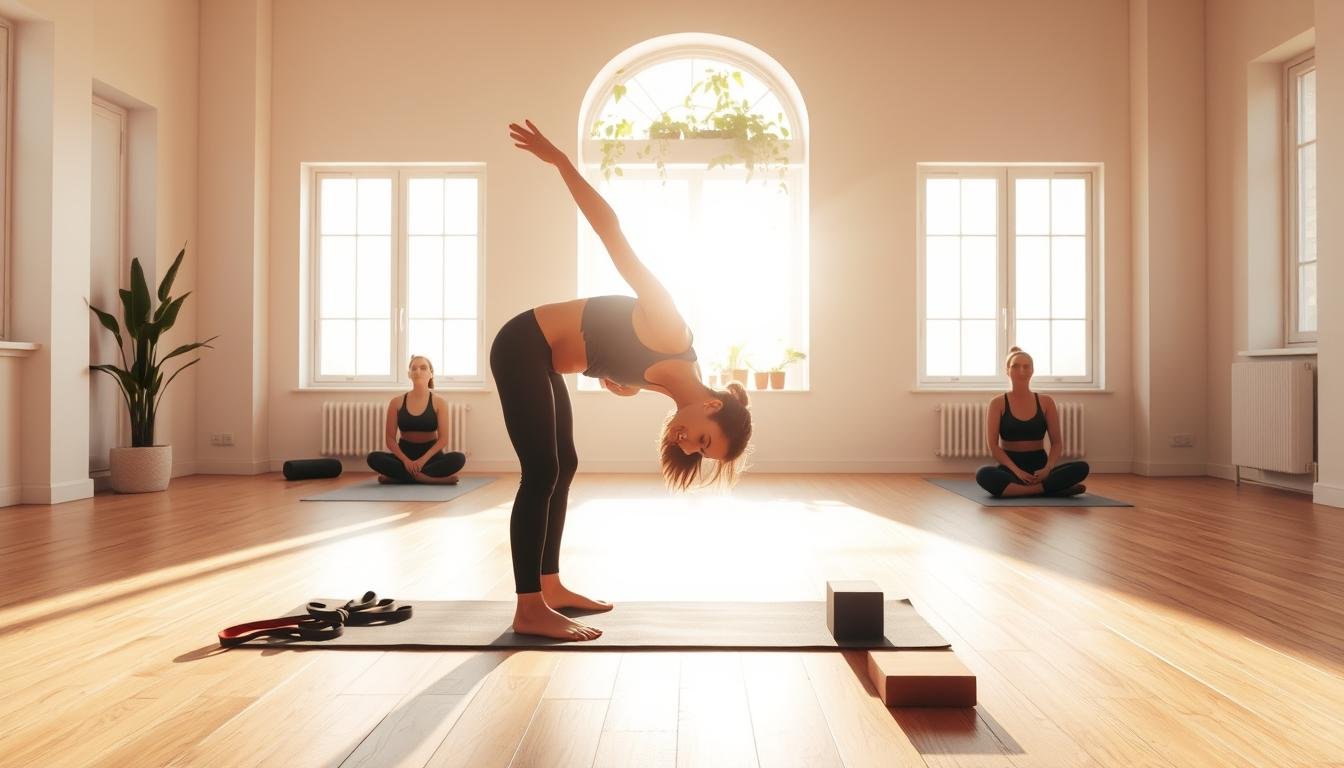Looking to boost your health and happiness? Adding daily stretching to your routine can make a big difference. Just a few minutes each day can lead to better flexibility and less muscle tension.
By making stretching a regular part of your day, you’ll feel more relaxed. You’ll also see your physical health get better. This article will show you why flexibility improvement matters and give you easy tips to start.
Key Takeaways
- Improve flexibility through daily stretching exercises
- Reduce muscle tension and enhance overall well-being
- Discover simple and effective stretches to incorporate into your daily routine
- Learn how daily stretching can improve your posture and balance
- Understand the benefits of stretching for overall physical health
The Science Behind Why Your Body Needs Stretching
Learning about stretching can change how you see flexibility exercises. Stretching regularly does more than just make you flexible. It also improves how your body works overall.
How Muscles Respond to Regular Stretching
Stretching often changes how muscles work. They get more flexible and strong. This happens because the fibers and tendons grow longer, letting you move more easily.
| Muscle Response | Short-term Effects | Long-term Effects |
|---|---|---|
| Flexibility | Increased range of motion | Improved muscle elasticity |
| Muscle Soreness | Initial soreness may occur | Reduced muscle soreness over time |
What Happens When You Skip Your Stretch Routine
Not stretching can make you less flexible and more sore. As Dr. John Smith, a renowned physiotherapist, says,
“Consistency is key when it comes to stretching. Skipping your routine can undo all the progress you’ve made.”
Without regular stretching, muscles get stiffer and more injury-prone.
Knowing how muscles react to stretching and what happens without it shows stretching’s value. It’s crucial to make flexibility exercises a part of your daily routine.
Physical Benefits of Consistent Stretching Routines
Regular stretching routines bring many physical benefits. They can make your life better. Stretching daily improves your health in many ways.
Improved Flexibility and Range of Motion
Stretching regularly makes you more flexible. This means you can move better and do things easier. It also lowers the chance of getting hurt.
Enhanced Muscle Recovery and Reduced Soreness
Stretching after working out helps your muscles recover. It makes them less sore and work better. This is great for people who do a lot of exercise.
Better Posture and Alignment
Stretching often can also improve your posture. It makes your muscles stronger and more flexible. Good posture looks better and helps avoid back pain.
Adding stretching to your daily routine can greatly benefit your health. It makes you feel better overall.
Mental and Emotional Advantages of Daily Stretching
Daily stretching can change your mental and emotional health. Adding stretching to your daily routine can lower stress and boost mental clarity.
Stress Reduction and Relaxation Response
Stretching triggers the relaxation response. This state is marked by lower blood pressure, heart rate, and cortisol levels. Regular stretching calms your mind and eases muscle tension, helping you relax.
As you stretch, focus on your breath. Let go of the day’s stress. This promotes calm and well-being.

Improved Focus and Mental Clarity
Daily stretching relaxes your body and sharpens your mental focus. It boosts blood flow and oxygen to the brain. This improves cognitive function, leading to better concentration and mental clarity.
Regular stretching will improve your mental and emotional health. It contributes to a better quality of life.
Why Body Stretching is Needed Daily for Optimal Health
Daily stretching is more than just good for you; it’s crucial for staying healthy. Adding stretching to your daily routine can greatly improve your health.
Regular stretching brings long-term benefits that make life better. These benefits include:
- Increased flexibility and range of motion
- Improved muscle recovery and reduced soreness
- Better posture and alignment
Long-term Benefits of Daily Practice
Sticking to daily stretching keeps your flexibility and mobility high. It keeps muscles long and joints moving freely. This lowers injury risk and boosts physical function.

Addressing Age-Related Mobility Concerns
As we get older, our mobility and flexibility decrease. But, daily stretching can slow down these changes. Regular stretching helps:
- Keep joints mobile
- Lessen muscle stiffness
- Improve physical function
This proactive approach to staying mobile greatly enhances your life as you age.
Essential Stretching Techniques for Your Daily Routine
Stretching every day is key to staying flexible and feeling good. It helps loosen tight muscles and boosts your mood.
Morning Wake-Up Stretches
Stretching in the morning wakes you up and gets your muscles ready. Morning stretches also improve blood flow and flexibility.
Full-Body Energizing Sequence
Start with neck stretches, shoulder rolls, and leg swings. This wakes up your muscles and gets your blood moving.
Targeted Stretches for Morning Stiffness
Focus on stretches for your lower back, hamstrings, and hip flexors. They help ease morning stiffness.
Workplace and Desk-Friendly Stretches
If you sit at a desk all day, workplace stretches can help. Simple stretches can be done right at your desk.
Quick 5-Minute Office Stretch Breaks
Take short breaks to stretch your wrists, shoulders, and back. These quick stretches reduce stress and boost productivity.
Stretches to Combat Sitting All Day
Try seated twists, leg raises, and chair squats. They counteract the effects of sitting for too long.
Evening Wind-Down Stretching Sequences
Evening stretches help your body relax for sleep. Choose gentle, calming stretches.
Relaxing Pre-Bedtime Stretches
Include stretches for major muscle groups like hamstrings, quadriceps, and back. They help your body unwind.
Stretches for Better Sleep Quality
Gentle stretching relaxes your body and calms your mind. It improves sleep quality.
| Time of Day | Stretching Focus | Benefits |
|---|---|---|
| Morning | Energizing and flexibility | Boosts energy, improves flexibility |
| Workplace | Desk-friendly stretches | Reduces sitting effects, improves productivity |
| Evening | Relaxation and unwinding | Improves sleep quality, relaxes muscles |
Common Stretching Mistakes and How to Avoid Them
To get the most out of your stretching exercises, it’s crucial to avoid common pitfalls. Stretching is a vital component of fitness, but when done incorrectly, it can lead to injuries or reduced effectiveness.
Improper Technique and Form
One of the most significant stretching mistakes is using improper technique and form. This can put unnecessary strain on your muscles and joints. To avoid this, focus on slow, controlled movements and listen to your body’s limits.
Overstretching and Injury Risks
Overstretching can lead to muscle strains and other injuries. It’s essential to understand your flexibility limits and not push beyond them. Gradual progression is key to improving flexibility safely.
Inconsistency and Timing Issues
Consistency is crucial when it comes to stretching. Irregular routines can hinder progress and reduce the benefits of stretching. Incorporate stretching into your daily routine, ideally at times when your muscles are warm, such as after a workout.
By being aware of these common stretching mistakes and taking steps to avoid them, you can maximize the benefits of your stretching routine and improve your overall flexibility and well-being.
Conclusion: Making Daily Stretching a Lifelong Habit
Adding daily stretching to your routine can greatly improve your health and well-being. It boosts flexibility, reduces muscle tension, and sharpens your mind. Start with simple stretches in the morning or at your desk to make it a habit.
Being consistent is crucial for stretching’s long-term benefits. Make stretching a must-do part of your day. This way, you’ll keep up with it and enjoy its benefits. Always listen to your body and adjust your stretches to avoid injuries and keep stretching for life.

